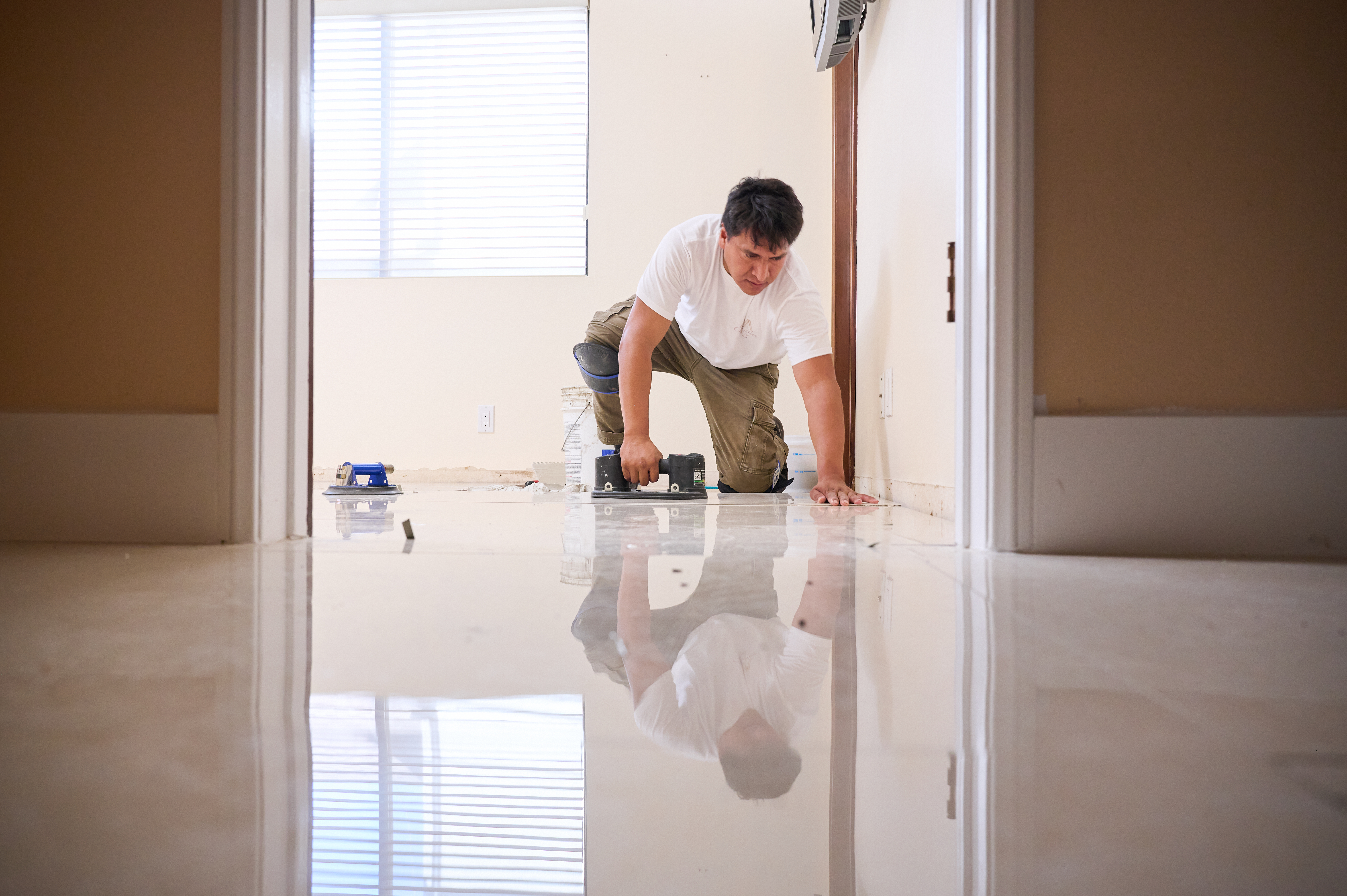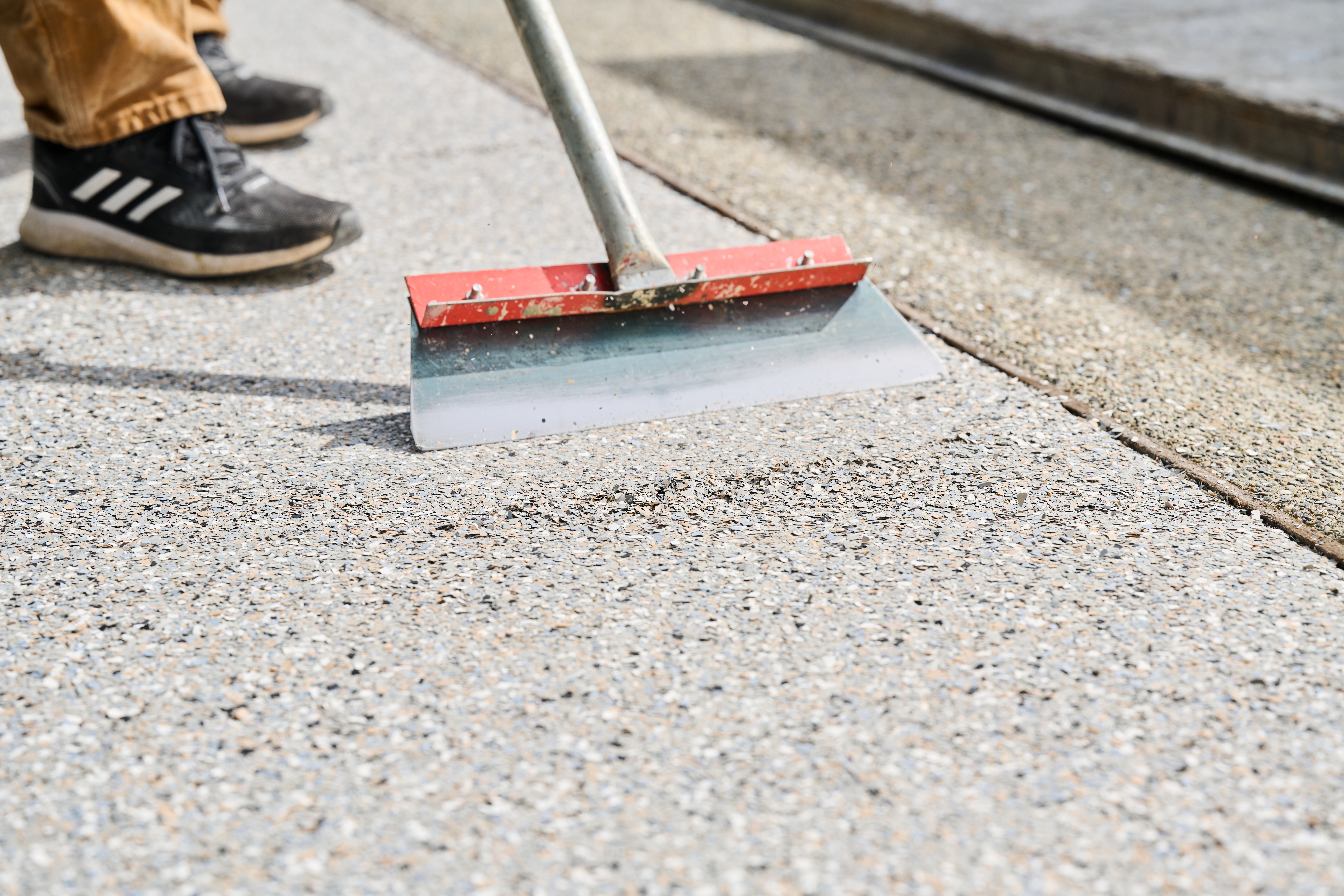
The cost to rip up carpets and install laminate depends on factors like labor prices, materials, and location. Use this guide to get a detailed cost overview.
Mitigate moisture concerns before your concrete floors get swamped


While professional flooring installation costs between $1,530 and $4,859, with an average price of $3,160, it might be worth it if you want to resolve a serious concrete moisture issue in a safe, efficient manner.
Depending on the nature of your moisture issue, it may be worth it to consult a waterproofing contractor or mold remediation company.
Since excessive moisture in your concrete flooring can lead to foundation issues, hiring a pro to test it can bring you peace of mind while saving you money and headaches down the road.
Homeowners may overlook moisture warning signs or apply the wrong materials, leading to costly repairs later on.
Pros have the tools to test for moisture levels and apply the correct sealants or barriers to prevent future damage.
Moisture in a home can be highly problematic. Concrete in particular absorbs and releases moisture and can potentially warp any wood flooring you put down if it has an elevated humidity content. You can stay ahead of any issues by keeping tabs on your home's moisture level. Looking for a DIY way to start? Here is how to test moisture in concrete floors.
It is important to test a concrete floor for moisture before you install flooring or apply a coating, like primer. This is because, while your concrete can look dry, it actually has a moisture content. This can come from the ground if the floor lacks a proper vapor barrier or from moisture in the air.
Your coating and flooring materials can handle certain thresholds of moisture, so you need to test your concrete and make sure its moisture levels are OK for what you want to install.
Check the manufacturer’s instructions for your concrete coating product or flooring materials to find out how much moisture your concrete floor can have.
If you skip this step and your concrete floor’s moisture content is too high, you may have to deal with issues down the road, like cracks and bubbling in your flooring, mold, warping, and more. Protect your investment in flooring installation costs by doing the proper preparation beforehand.
You can choose between a couple of concrete moisture tests—the plastic sheet method or the calcium chloride test.
In order to test moisture emissions from concrete, you will need to create a plastic entrapment on the concrete that will show any beads of moisture. Measure out a square around two feet in length from a roll of polyethylene sheeting and carefully cut it with scissors or a razor blade, making sure not to create any tears or snags.
Choose a dry area of your concrete floor and tightly tape plastic all along the edge of your square so it creates an airtight seal that will trap any moisture within. Run your fingernail along each tape edge to ensure a proper seal.
After 48 hours, return to your test site to inspect the plastic. If there are droplets of moisture on top of the plastic, the room is humid and generating moisture. If you peel up the plastic and find it is damp beneath, you might have a moisture problem in your concrete. Conversely, if there are no immediate signs of water, moisture levels in the concrete are likely at safe levels.
If you find damp plastic, you can run a dehumidifier in the room and try the test again after a day or so to double-check your initial effort. You can also use a moisture meter for an accurate reading on levels and to measure the humidity in your home. Wagner Meters is one brand that produces these devices found at home improvement stores.
An alternate method to use is the calcium chloride test method. Place a dish of calcium chloride within the airtight plastic dome to get a visual of the moisture vapor emission (MVE) rate that your concrete slab produces. According to the Association for Materials Protection and Performance, once you place the dish beneath the plastic, wait for 60 to 72 hours, then weigh the dish to record pounds of water emitted per 1,000 square feet. This test can be effective, but it is not foolproof as it evaluates the top half-inch of the concrete slab, where 90% of MVE occurs. If you want to measure deeper than ¾ inch below the concrete surface, you will need to use a backup method to ensure that you are getting an accurate read on the moisture condition.
To get the proper reading for your concrete floor moisture level, it is best to conduct your test after you run the HVAC for 48 hours.
Also, if you want the most accurate reading possible, you can call in a pro to conduct a relative humidity (RH) test. They will drill holes into the floor and use a thermo-hygrometer to check readings deep in the concrete. This option will help you figure out the actual moisture levels inside the slab, rather than what is on the surface.
The best DIY methods for testing your concrete moisture levels are the plastic sheeting method and the calcium chloride test, which you can purchase for around $20. If you are familiar with drilling holes into concrete, you can get a RH test kit, although this can cost as much as $820. So, unless you are planning on doing multiple construction projects, it is likely better bang for your buck to call in a pro to do the thermo-hygrometer test for you.
If you suspect a more serious moisture issue in your home, you will want to hire a flooring company near you. You can also reach out to a waterproofing contractor or mold remediation company.
From average costs to expert advice, get all the answers you need to get your job done.

The cost to rip up carpets and install laminate depends on factors like labor prices, materials, and location. Use this guide to get a detailed cost overview.

Laminate is a solid choice for many homes because it's durable and budget-friendly. Check out this guide to learn about laminate flooring installation costs.

Terrazzo may cost more than many other flooring options, but its longevity and high return on investment make it worthwhile.

If you’re dealing with warped or creaky floors, it could be a subfloor issue. This guide will show you how to replace a subfloor totally DIY.

Baseboards come in many styles and materials, giving your space a finished look. Learn about the types of baseboards, pros and cons, and when to choose each.

Looking for cheap flooring options? Learn about vinyl, linoleum, laminate, cork, concrete, and carpeting, along with tips for finding inexpensive flooring.